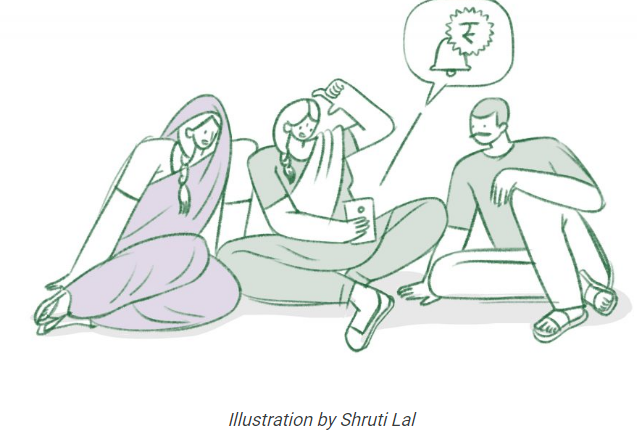Gender and gig work: Perspectives from domestic work in India
Platforms have the potential to be instrumental in protecting workers rights, but the current platform design is not optimised to protect workers’ interests especially those of women in the gig economy, argues Ambika Tandon, a senior researcher at the Centre for Internet and Society in India and an author of the report on ‘Platforms, Power and Politics: Perspectives from Domestic and Care Work in India’.
Digital labour platforms, broadly defined as digital interfaces that enable the exchange of goods or services, have grown exponentially in cities across the world. In sectors such as transportation and delivery, Uber and similar platforms have achieved dominant status, while in other sectors platforms are still making inroads to transform consumption patterns. Researchers at India’s Centre for Internet and Society, sought to understand the impact platforms have had on the paid domestic and care work sector in India, given its importance for women workers. The workforce in this sector is largely constituted of women from Dalit, Bahujan and Adivasi (or caste-oppressed) and low-income groups, with a long history of socioeconomic and legal devaluation and lack of recognition. In this context, platforms have positioned themselves as intermediaries that will improve wages and conditions of work, pushing the sector towards formalisation.
To assess the impact of digital platforms on processes of recruitment and placement and on organisation and conditions of work, we undertook 60 in-depth interviews between June and November 2019. We chose two metropolitan cities, New Delhi in north India and Bengaluru in south India, as our field sites. These are key nodes in the migration corridors of domestic workers in the country. We spoke to workers who were searching for hourly or regular work through platforms, representatives of platform companies and state and central governments, as well as domestic workers unions. We found that platform design breeds and amplifies exclusion and discrimination along the lines of gender and caste, among other social characteristics.

Uber for domestic work
We found that the function of digital platforms in the sector is contingent on the historical organisation of domestic work, rather than any fundamental re-organisation of the supply chain. Unlike in the global North, platforms in India have thus far been unable to ‘gig-ify’, that is, break up most tasks that constitute domestic work – including child and elderly care and cooking – into short-term granular services that have been standardised. Domestic workers continue to find regular term full-time placements through marketplace platforms, which only connect employers to workers with no other role in determining work conditions. HelpersNearMe and Helper4u are examples of platforms that play this role by listing profiles of workers and making these available to employers. These placements are no different from work in the ‘offline’ sector, with complete informality and very little standardisation around hours, wages, and task constitution. As compared to this, on-demand platforms that offer short-term gigs (similar to the Uber model) have grown exponentially in the ‘deep’ cleaning segment by marketing it as a professional service with higher value than ‘regular’ cleaning services.
The function of digital platforms in the sector is contingent on the historical organisation of domestic work, rather than any fundamental re-organisation of the supply chain.
Cleaning gigs provided by on-demand companies have higher hourly wages than ‘regular’ cleaning services in the traditional sector. But accessing these opportunities requires workers to have regular access to a smartphone throughout the day, to be able to accept or reject tasks and receive payments through a mobile application or web-portal. Women workers from low income families have very low levels of digital access, with most phones being shared between families and controlled by male members. Also, the use of technical equipment such as vacuum cleaners and chemicals has led to deep cleaning being viewed as a masculine task. As a result, almost all cleaning workers we identified in the on-demand sector were men, even though cleaning is a feminised job role in the traditional economy. Some cleaning workers we spoke to did not identify as domestic workers at all, but rather viewed their work as holding a higher status than traditional cleaning. This trend of masculinisation of a job role coinciding with higher wages and social status has also been seen in other sectors globally, such as software programming.

Promises and risks of low-tech platforms
One of the reasons that women workers are more likely to find work through marketplace platforms rather than on-demand agencies is because they only require workers to have a basic or feature phone for one-time registration, and subsequently to answer calls from potential employers or the platform. Most platforms in this category do not intervene in task allocation or terms of work, which are negotiated directly between workers and employers. Algorithms and digital interfaces then only facilitate matching, as opposed to on-demand work where all aspects of the job are determined by the platform. This allows women workers to register using shared family phones, or those of their friends, neighbours, and in the case of one of our respondents, her landlady’s phone number. These platforms then may be able to provide placement opportunities to workers who are unable to find work through word-of-mouth networks. This is especially crucial as a result of the unemployment crisis triggered by the COVID-19 pandemic. However, unlike with the on-demand model, these platforms do not offer increased wages or provide better conditions of work.
Although marketplace platforms provide an additional route into finding opportunities in the sector, they also codify employers’ biases through their design. All marketplace platforms and digital placement agencies we reviewed – upwards of 20 companies – provide demographic filters to employers for filtering workers’ profiles. These include information on workers’ gender, age, religion, state of origin, and in one case, even caste. While practices of employing workers based on demographic characteristics are rampant in the sector historically, platforms build them in by design and market them as a key feature of what they are able to offer employers. These open up direct avenues for employers to discriminate against workers from minority religions and oppressed castes. It also reinforces gendered occupational segregation, as employers seek out women workers for feminised roles such as cleaning and care work, and men for tasks such as gardening and plumbing.
Power structures endemic to the domestic work sector continue to thrive in the platform economy, as do gender and caste-based occupational segregation.
Platforms have been making claims of formalising the informal sector, especially in global South economies, through increasing efficiency in matching workers to employers. Despite having the potential to be instrumental in protecting workers rights, currently platform design is not optimised to protect workers’ interests. Power structures endemic to the domestic work sector continue to thrive in the platform economy, as do gender and caste-based occupational segregation. To be able to nudge the sector towards formalisation, platforms need to directly intervene in power structures and co-design with workers, rather than merely functioning as digital recruiters. This could imply adopting practices such as removing demographic details where not relevant, introducing written contracts and minimum wage floors for placements, and addressing gender gaps in some segments of the digital economy.
This work forms part of a project on ‘Platforms, Power and Politics: Perspectives from Domestic and Care Work in India’, supported by the Association for Progressive Communications. You can read more about the project here, and find the full project report here.
This article gives the views of the author and does not represent the position of the Media@LSE blog, nor of the London School of Economics and Political Science.
The blog first published on LSE website can be accessed here

